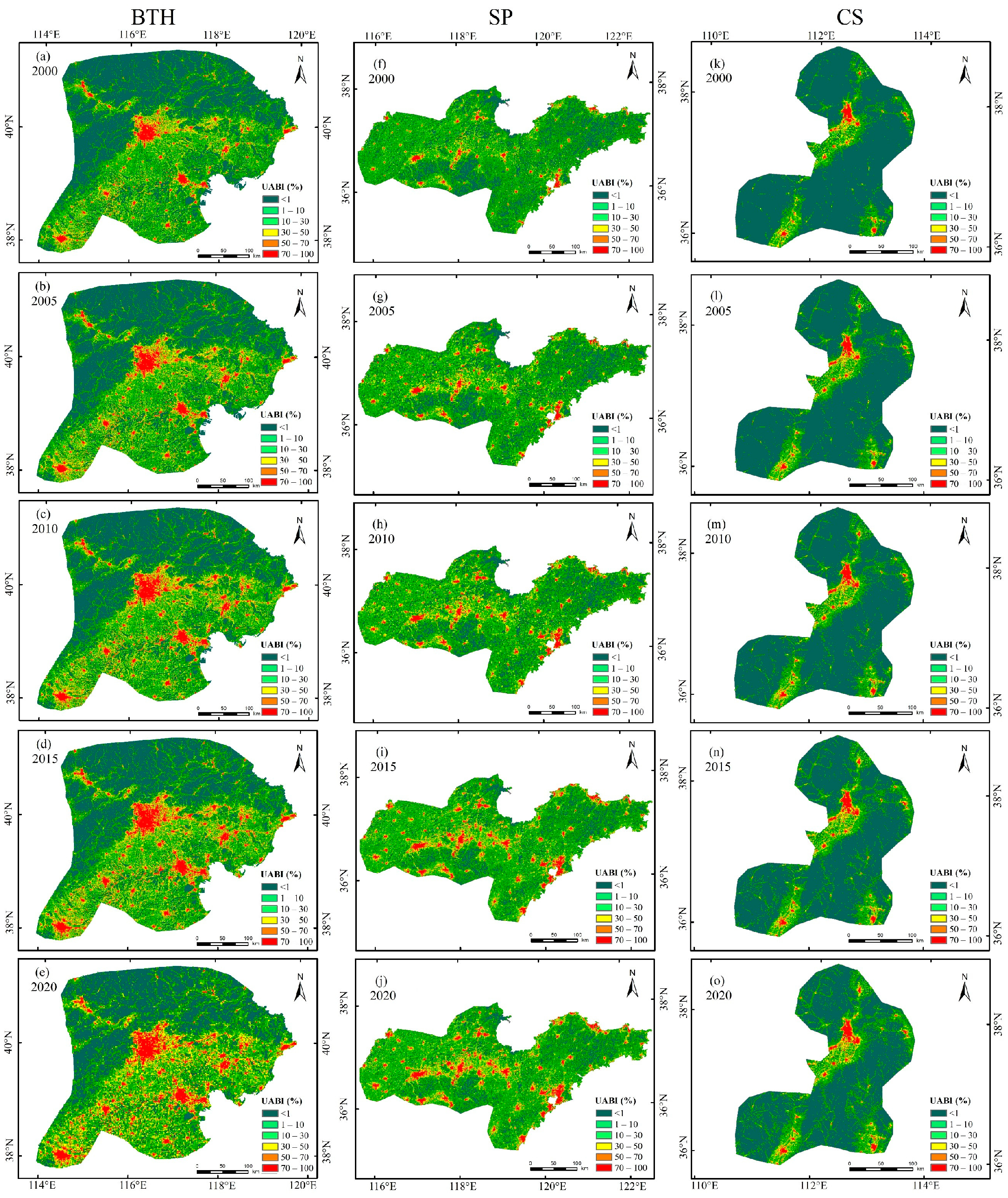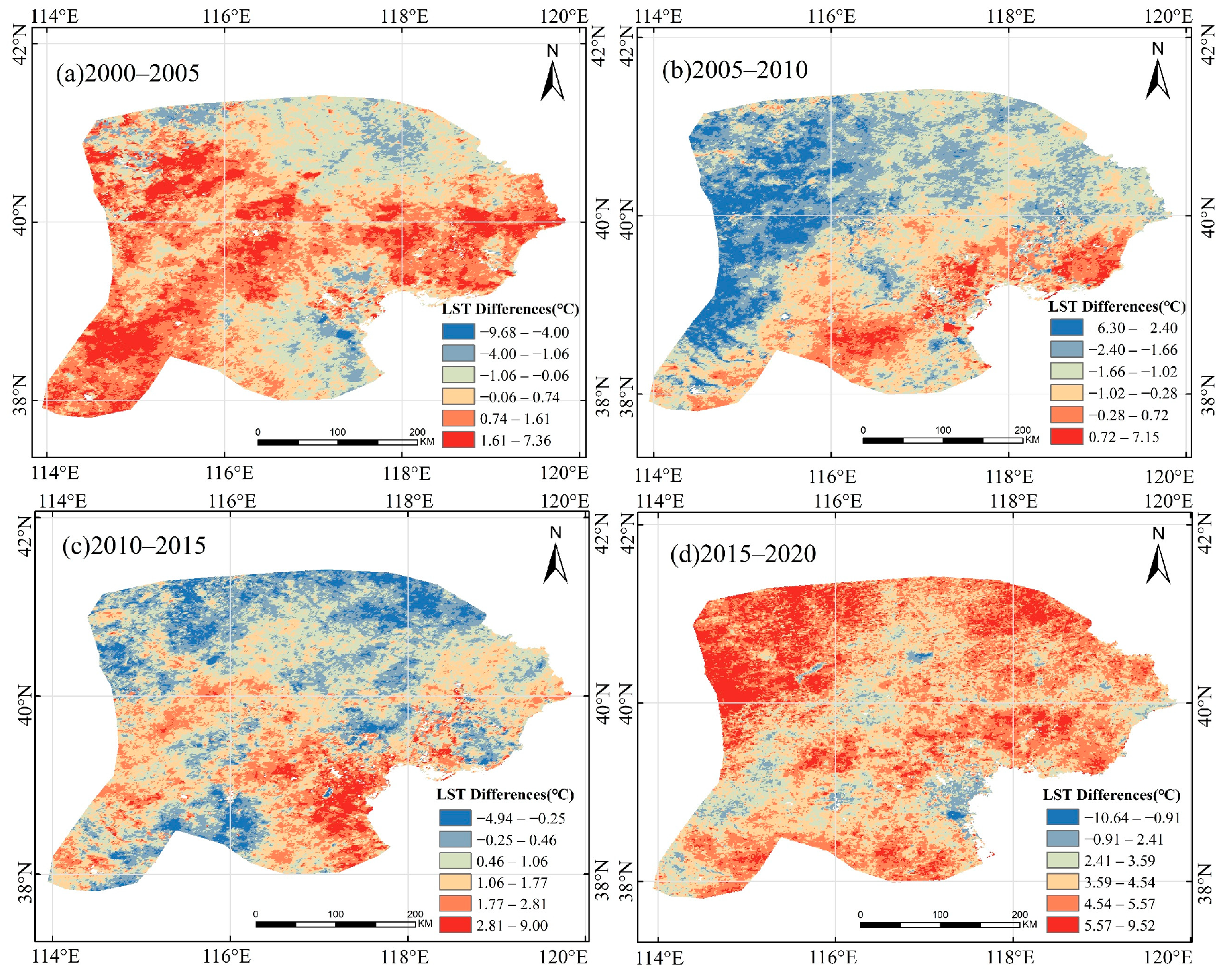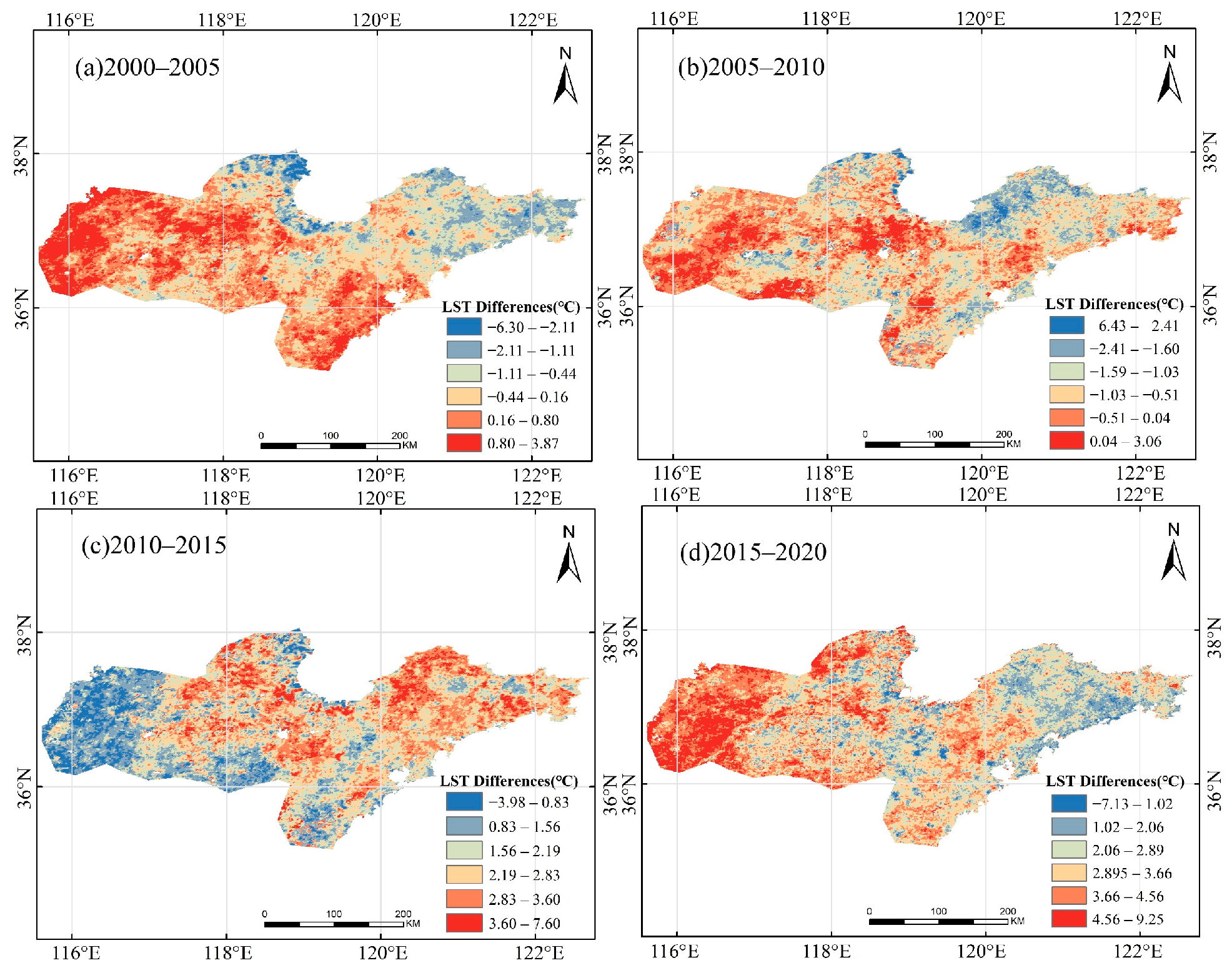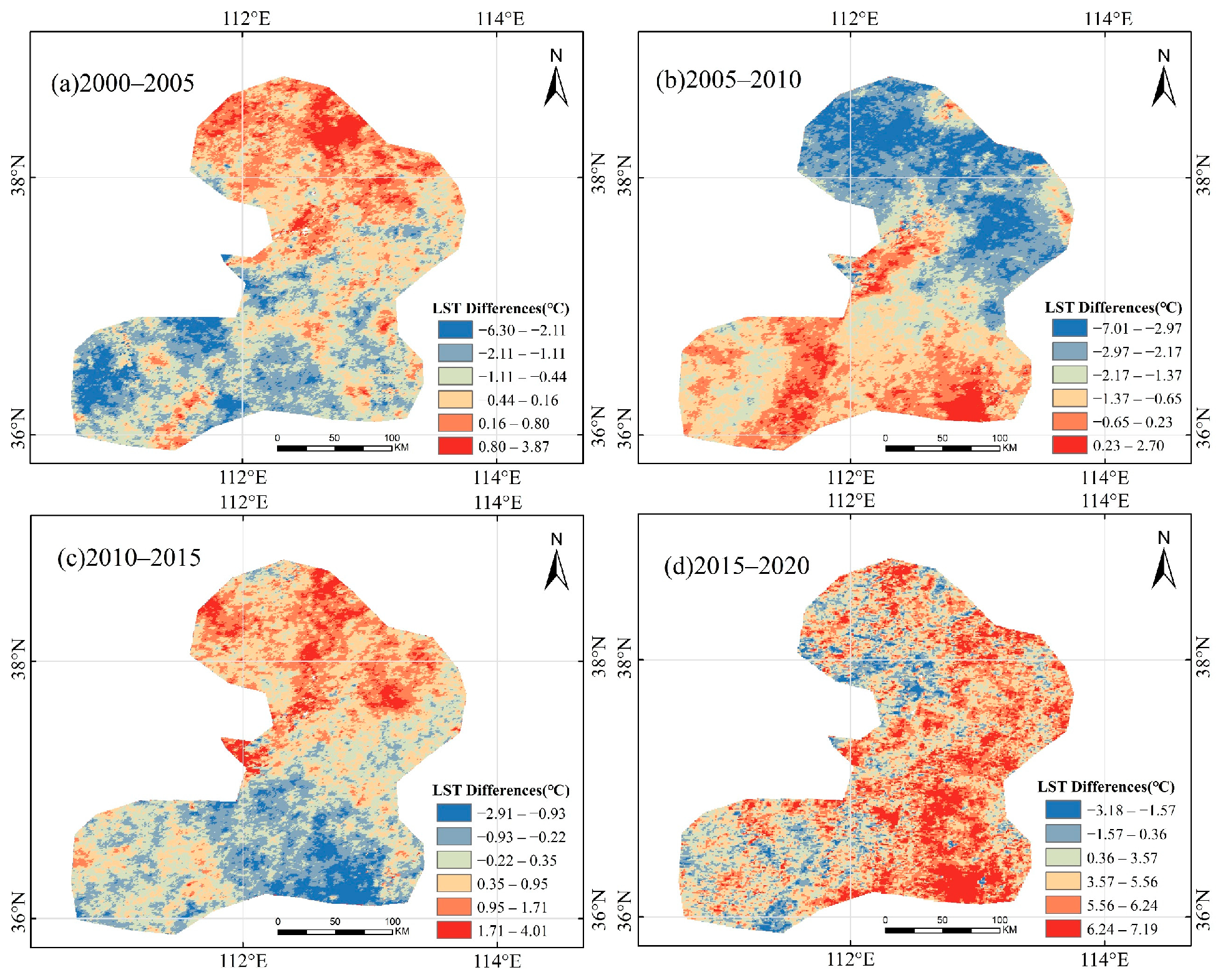Comparing the Evolution of Land Surface Temperature and Driving Factors between Three Different Urban Agglomerations in China
Abstract
1. Introduction
2. Materials and Methods
2.1. Study Area Overview
2.2. Data Sources and Pre-Processing
2.3. Urban Agglomeration Built-Up Area Intensity (UABI)
2.4. Land Surface Temperature Classification
2.5. Spatial Analysis and Statistical Regression Methods
2.6. Geo-Detector Model
3. Results
3.1. Spatial and Temporal Distribution of UABI in UAs of Different Levels
3.2. Characterization of the Spatial Evolution of LST in UAs of Different Levels
3.3. Temporal Trends of LST in UAs of Different Levels
3.4. Changing Trends in the Effect of UABI on LST in UAs of Different Levels
3.5. Results of the Driving Factors of Geo-detector in UAs of Different Levels
4. Discussion
4.1. Differences in Spatial Distribution Patterns of UABI
4.2. Differences in Spatial Patterns of LST
4.3. Differences in Temporal Evolution of LST
4.4. Differences in Driving Mechanisms of LST
4.5. Differences and Similarities of Thermal Environments in UAs of Different Levels
5. Conclusions
- UAs of different levels showed a gradual evolution of LST. There was a positive correlation between the proportion of high-LST areas and the number of core cities. Urban heat islands (UHIs) were mainly concentrated in and around core cities.
- UABI was the indicator factor that had the strongest effect on LST following DEM in the three UAs. Particularly in the city-level UAs, the LST increased by 1.83 °C for every 10% increase in UABI.
- In national-level and regional-level UAs, the interactions of some factors with POP showed certain cooling effects on LST. In contrast, in the city-level UA, all factors and their interactions enhanced LST, albeit with varying intensities.
Author Contributions
Funding
Institutional Review Board Statement
Data Availability Statement
Conflicts of Interest
References
- Massaro, E.; Schifanella, R.; Piccardo, M.; Caporaso, L.; Taubenböck, H.; Cescatti, A.; Duveiller, G. Spatially-optimized urban greening for reduction of population exposure to land surface temperature extremes. Nat. Commun. 2023, 14, 2903. [Google Scholar] [CrossRef] [PubMed]
- Osborn, T.J.; Jones, P.D.; Lister, D.H.; Morice, C.P.; Simpson, I.R.; Winn, J.; Hogan, E.; Harris, I.C. Land surface air temperature variations across the globe updated to 2019: The CRUTEM5 data set. J. Geophys. Res. Atmos. 2021, 126, e2019JD032352. [Google Scholar] [CrossRef]
- Cai, D.; Fraedrich, K.; Guan, Y.; Guo, S.; Zhang, C.; Sun, R.; Wu, Z. Remote Sensing Greenness and Urbanization in Ecohydrological Model Analysis: Asia and Australasia (1982–2015). Sensors 2019, 19, 4693. [Google Scholar] [CrossRef] [PubMed]
- Oke, T.R. The energetic basis of the urban heat island. Q. J. R. Meteorol. Soc. 1982, 108, 1–24. [Google Scholar] [CrossRef]
- Cai, D.; Fraedrich, K.; Guan, Y.; Guo, S.; Zhang, C.; Zhu, X. Urbanization and climate change: Insights from eco-hydrological diagnostics. Sci. Total Environ. 2019, 647, 29–36. [Google Scholar] [CrossRef] [PubMed]
- Huang, K.; Li, X.; Liu, X.; Seto, K.C. Projecting global urban land expansion and heat island intensification through 2050. Environ. Res. Lett. 2019, 14, 114037. [Google Scholar] [CrossRef]
- Fang, C.; Yu, D. Urban agglomeration: An evolving concept of an emerging phenomenon. Landsc. Urban Plan. 2017, 162, 126–136. [Google Scholar] [CrossRef]
- Dadashpoor, H.; Azizi, P.; Moghadasi, M. Land use change, urbanization, and change in landscape pattern in a metropolitan area. Sci. Total Environ. 2019, 655, 707–719. [Google Scholar] [CrossRef]
- Fang, C.; Liu, H.; Wang, S. The coupling curve between urbanization and the eco-environment: China’s urban agglomeration as a case study. Ecol. Indic. 2021, 130, 108107. [Google Scholar] [CrossRef]
- Liu, H.; He, B.-J.; Gao, S.; Zhan, Q.; Yang, C. Influence of non-urban reference delineation on trend estimate of surface urban heat island intensity: A comparison of seven methods. Remote Sens. Environ. 2023, 296, 113735. [Google Scholar] [CrossRef]
- Jiménez-Muñoz, J.C.; Sobrino, J.A.; Skoković, D.; Mattar, C.; Cristobal, J. Land surface temperature retrieval methods from Landsat-8 thermal infrared sensor data. IEEE Geosci. Remote Sens. Lett. 2014, 11, 1840–1843. [Google Scholar] [CrossRef]
- Li, Y.; Zhou, D.-C.; Yan, Z.-M. Spatiotemporal variations in atmospheric urban heat island effects and their driving factors in 84 major Chinese cities. Huan Jing Ke Xue Huanjing Kexue 2021, 42, 5037–5045. [Google Scholar] [PubMed]
- Li, Y.; Wang, L.; Liu, M.; Zhao, G.; He, T.; Mao, Q. Associated determinants of surface urban heat islands across 1449 cities in China. Adv. Meteorol. 2019, 2019, 4892714. [Google Scholar] [CrossRef]
- Zheng, Y.; Liu, S.; He, P.; Miao, Y.; Wang, S. Numerical Study of Summertime Urban Heat Island in Dianzhong. Beijing Da Xue Xue Bao 2017, 53, 639–651. [Google Scholar]
- Schwarz, N.; Manceur, A.M. Analyzing the influence of urban forms on surface urban heat islands in Europe. J. Urban Plan. Dev. 2015, 141, A4014003. [Google Scholar] [CrossRef]
- Yang, C.; Yan, F.; Lei, X.; Ding, X.; Zheng, Y.; Liu, L.; Zhang, S. Investigating seasonal effects of dominant driving factors on urban land surface temperature in a snow-climate city in China. Remote Sens. 2020, 12, 3006. [Google Scholar] [CrossRef]
- Adulkongkaew, T.; Satapanajaru, T.; Charoenhirunyingyos, S.; Singhirunnusorn, W. Effect of land cover composition and building configuration on land surface temperature in an urban-sprawl city, case study in Bangkok Metropolitan Area, Thailand. Heliyon 2020, 6, e04485. [Google Scholar] [CrossRef]
- Zhao, H.; Tan, J.; Ren, Z.; Wang, Z. Spatiotemporal characteristics of urban surface temperature and its relationship with landscape metrics and vegetation cover in rapid urbanization region. Complexity 2020, 2020, 7892362. [Google Scholar] [CrossRef]
- Jay, O.; Capon, A.; Berry, P.; Broderick, C.; de Dear, R.; Havenith, G.; Honda, Y.; Kovats, R.S.; Ma, W.; Malik, A. Reducing the health effects of hot weather and heat extremes: From personal cooling strategies to green cities. Lancet 2021, 398, 709–724. [Google Scholar] [CrossRef]
- Imran, H.M.; Kala, J.; Ng, A.; Muthukumaran, S. Effectiveness of green and cool roofs in mitigating urban heat island effects during a heatwave event in the city of Melbourne in southeast Australia. J. Clean. Prod. 2018, 197, 393–405. [Google Scholar] [CrossRef]
- Dugord, P.-A.; Lauf, S.; Schuster, C.; Kleinschmit, B. Land use patterns, temperature distribution, and potential heat stress risk–the case study Berlin, Germany. Computers. Environ. Urban Syst. 2014, 48, 86–98. [Google Scholar] [CrossRef]
- Gunawardena, K.R.; Wells, M.J.; Kershaw, T. Utilising green and bluespace to mitigate urban heat island intensity. Sci. Total Environ. 2017, 584, 1040–1055. [Google Scholar] [CrossRef] [PubMed]
- Fu, X.; Yao, L.; Xu, W.; Wang, Y.; Sun, S. Exploring the multitemporal surface urban heat island effect and its driving relation in the Beijing-Tianjin-Hebei urban agglomeration. Appl. Geogr. 2022, 144, 102714. [Google Scholar] [CrossRef]
- Li, K.; Chen, Y.; Wang, M.; Gong, A. Spatial-temporal variations of surface urban heat island intensity induced by different definitions of rural extents in China. Sci. Total Environ. 2019, 669, 229–247. [Google Scholar] [CrossRef] [PubMed]
- Fan, W.; Song, X.; Liu, M.; Shan, B.; Ma, M.; Liu, Y. Spatio-temporal evolution of resources and environmental carrying capacity and its influencing factors: A case study of Shandong Peninsula urban agglomeration. Environ. Res. 2023, 234, 116469. [Google Scholar] [CrossRef] [PubMed]
- Saha, S.; Saha, A.; Das, M.; Saha, A.; Sarkar, R.; Das, A. Analyzing spatial relationship between land use/land cover (LULC) and land surface temperature (LST) of three urban agglomerations (UAs) of Eastern India. Remote Sens. Appl. Soc. Environ. 2021, 22, 100507. [Google Scholar] [CrossRef]
- Johnson, S.; Ross, Z.; Kheirbek, I.; Ito, K. Characterization of intra-urban spatial variation in observed summer ambient temperature from the New York City Community Air Survey. Urban Clim. 2020, 31, 100583. [Google Scholar] [CrossRef]
- Barlow, J.; Best, M.; Bohnenstengel, S.I.; Clark, P.; Grimmond, S.; Lean, H.; Christen, A.; Emeis, S.; Haeffelin, M.; Harman, I.N. Developing a research strategy to better understand, observe, and simulate urban atmospheric processes at kilometer to subkilometer scales. Bull. Am. Meteorol. Soc. 2017, 98, ES261–ES264. [Google Scholar] [CrossRef]
- Best, M.J.; Grimmond, C.S.B. Key conclusions of the first international urban land surface model comparison project. Bull. Am. Meteorol. Soc. 2015, 96, 805–819. [Google Scholar] [CrossRef]
- Bohnenstengel, S.; Belcher, S.; Aiken, A.; Allan, J.; Allen, G.; Bacak, A.; Bannan, T.; Barlow, J.; Beddows, D.C.; Bloss, W. Meteorology, air quality, and health in London: The ClearfLo project. Bull. Am. Meteorol. Soc. 2015, 96, 779–804. [Google Scholar] [CrossRef]
- Liu, L.; Lei, Y.; Zhuang, M.; Ding, S. The impact of climate change on urban resilience in the Beijing-Tianjin-Hebei region. Sci. Total Environ. 2022, 827, 154157. [Google Scholar] [CrossRef] [PubMed]
- Zhai, F.; Liu, Z.; Li, P.; Gu, Y.; Hu, L.; Sun, L.; Yang, B. Monthly and Interannual Variations in Winter Positive Surface-Bottom Temperature Difference in Northeastern Coastal Waters of the Shandong Peninsula in the Yellow Sea. J. Geophys. Res. Ocean. 2021, 126, e2021JC017562. [Google Scholar] [CrossRef]
- Freitas, S.C.; Trigo, I.F.; Bioucas-Dias, J.M.; Gottsche, F.-M. Quantifying the uncertainty of land surface temperature retrievals from SEVIRI/Meteosat. IEEE Trans. Geosci. Remote Sens. 2009, 48, 523–534. [Google Scholar] [CrossRef]
- Freitas, S.C.; Trigo, I.F.; Macedo, J.; Barroso, C.; Silva, R.; Perdigão, R. Land surface temperature from multiple geostationary satellites. Int. J. Remote Sens. 2013, 34, 3051–3068. [Google Scholar] [CrossRef]
- Trigo, I.F.; Monteiro, I.T.; Olesen, F.; Kabsch, E. An assessment of remotely sensed land surface temperature. J. Geophys. Res. Atmos. 2008, 113, 1–12. [Google Scholar] [CrossRef]
- Jia, W.; Zhao, S. Trends and drivers of land surface temperature along the urban-rural gradients in the largest urban agglomeration of China. Sci. Total Environ. 2020, 711, 134579. [Google Scholar] [CrossRef] [PubMed]
- Cui, Y.; Xu, X.; Dong, J.; Qin, Y. Influence of urbanization factors on surface urban heat island intensity: A comparison of countries at different developmental phases. Sustainability 2016, 8, 706. [Google Scholar] [CrossRef]
- Cruz, J.; Blanco, A.; Garcia, J.; Santos, J.; Moscoso, A. Evaluation of the cooling effect of green and blue spaces on urban microclimate through numerical simulation: A case study of Iloilo River Esplanade, Philippines. Sustain. Cities Soc. 2021, 74, 103184. [Google Scholar] [CrossRef]
- Yang, C.; Zhu, W.; Sun, J.; Xu, X.; Wang, R.; Lu, Y.; Zhang, S.; Zhou, W. Assessing the effects of 2D/3D urban morphology on the 3D urban thermal environment by using multi-source remote sensing data and UAV measurements: A case study of the snow-climate city of Changchun, China. J. Clean. Prod. 2021, 321, 128956. [Google Scholar] [CrossRef]
- Yang, C.; Yan, F.; Zhang, S. Comparison of land surface and air temperatures for quantifying summer and winter urban heat island in a snow climate city. J. Environ. Manag. 2020, 265, 110563. [Google Scholar] [CrossRef]
- Shen, Z.; Xu, X.; Xu, S.; Sun, D. A comparative study of land development patterns and regional thermal environments (RTEs) in typical urban agglomerations of China and America: A case study of Beijing-Tianjin-Hebei (BTH) and Boswash. Sci. Total Environ. 2022, 803, 149735. [Google Scholar] [CrossRef] [PubMed]
- Wang, J.F.; Li, X.H.; Christakos, G.; Liao, Y.L.; Zhang, T.; Gu, X.; Zheng, X.Y. Geographical detectors-based health risk assessment and its application in the neural tube defects study of the Heshun Region, China. Int. J. Geogr. Inf. Sci. 2010, 24, 107–127. [Google Scholar] [CrossRef]
- Wang, J.-F.; Zhang, T.-L.; Fu, B.-J. A measure of spatial stratified heterogeneity. Ecol. Indic. 2016, 67, 250–256. [Google Scholar] [CrossRef]
- Zhao, R.; Zhan, L.; Yao, M.; Yang, L. A geographically weighted regression model augmented by Geodetector analysis and principal component analysis for the spatial distribution of PM2.5. Sustain. Cities Soc. 2020, 56, 102106. [Google Scholar] [CrossRef]
- Wang, H.; Qin, F.; Xu, C.; Li, B.; Guo, L.; Wang, Z. Evaluating the suitability of urban development land with a Geodetector. Ecol. Indic. 2021, 123, 107339. [Google Scholar] [CrossRef]
- Wang, Y.; Wang, X.; Chen, W.; Qiu, L.; Wang, B.; Niu, W. Exploring the path of inter-provincial industrial transfer and carbon transfer in China via combination of multi-regional input–output and geographically weighted regression model. Ecol. Indic. 2021, 125, 107547. [Google Scholar] [CrossRef]
- Wang, Y.; Wen, H.; Sun, D.; Li, Y. Quantitative assessment of landslide risk based on susceptibility mapping using random forest and geodetector. Remote Sens. 2021, 13, 2625. [Google Scholar] [CrossRef]
- Tao, H.; Liao, X.; Li, Y.; Xu, C.; Zhu, G.; Cassidy, D.P. Quantifying influences of interacting anthropogenic-natural factors on trace element accumulation and pollution risk in karst soil. Sci. Total Environ. 2020, 721, 137770. [Google Scholar] [CrossRef]
- Huang, S.; Yu, L.; Cai, D.; Zhu, J.; Liu, Z.; Zhang, Z.; Nie, Y.; Fraedrich, K. Driving mechanisms of urbanization: Evidence from geographical, climatic, social-economic and nighttime light data. Ecol. Indic. 2023, 148, 110046. [Google Scholar] [CrossRef]
- Good, E.J.; Ghent, D.J.; Bulgin, C.E.; Remedios, J.J. A spatiotemporal analysis of the relationship between near-surface air temperature and satellite land surface temperatures using 17 years of data from the ATSR series. J. Geophys. Res. Atmos. 2017, 122, 9185–9210. [Google Scholar] [CrossRef]
- Chen, Y.; Zhou, Y.; Zhang, H.; Wang, C.; Wang, X. Spatiotemporal variations of surface ozone and its influencing factors across Tibet: A Geodetector-based study. Sci. Total Environ. 2022, 813, 152651. [Google Scholar] [CrossRef] [PubMed]
- Yang, C.; He, X.; Yan, F.; Yu, L.; Bu, K.; Yang, J.; Chang, L.; Zhang, S. Mapping the influence of land use/land cover changes on the urban heat island effect—A case study of Changchun, China. Sustainability 2017, 9, 312. [Google Scholar] [CrossRef]
- Feng, Z.; Wang, X.; Yuan, J.; Zhang, Y.; Yu, M. Changes in air pollution, land surface temperature, and urban heat islands during the COVID-19 lockdown in three Chinese urban agglomerations. Sci. Total Environ. 2023, 892, 164496. [Google Scholar] [CrossRef] [PubMed]
- Cai, D.; Fraedrich, K.; Guan, Y.; Guo, S.; Zhang, C. Urbanization and the thermal environment of Chinese and US-American cities. Sci. Total Environ. 2017, 589, 200–211. [Google Scholar] [CrossRef]
- He, B.-J. Cause-related injustice, process-related injustice, effect-related injustice and regional heat action planning priorities: An empirical study in Yangtze River Delta and Chengdu-Chongqing urban agglomerations. Landsc. Urban Plan. 2023, 237, 104800. [Google Scholar] [CrossRef]








| Data | Data Description | Data Sources | Data Use |
|---|---|---|---|
| Scope of the UAs | Scope of the current status of urban agglomeration construction | Atlas of Chinese Cities | UA built-up area identification |
| Land cover | 30 m nationwide annual land cover data | Zenodo Data Download Center | Charting |
| Land surface temperature | 1 km monthly mean LST data product, MODIS 11A2 | Geospatial Data Cloud and NASA | Dynamic analysis |
| Impervious surface | 30 m impervious-surface dynamic dataset | Zenodo Data Download Center Produced by L Liu Team, CAS | Calculation of |
| NDVI | Monthly mean NDVI data with 1 km accuracy based on MODIS 13A3 data | National Aeronautics and Space Administration | Attributional analysis |
| Population density (POP) | Land Scan 1 km Precision Population Density Data | Produced by Oak Ridge National Laboratory | Attributional analysis |
| Temperature (T2m) | ERA5-Land dataset (air temperature at 2 m above ground surface) | EU and European Center for Medium-Range Weather Forecasts | Attributional analysis |
| NLSST Rating | NLST Division Threshold |
|---|---|
| Extremely low temperature | NLST < NLSTmean −1.5S |
| Low temperature | NLSTmean −1.5S ≤ NLST < NLSTmean −1.0S |
| Lower temperature | NLSTmean −1.0S ≤ NLST < NLSTmean −0.5S |
| Medium temperature | NLSTmean −0.5S ≤ NLST < NLSTmean +0.5S |
| Higher temperature | NLSTmean +0.5S ≤ NLST < NLSTmean +1.0S |
| High temperature | NLSTmean +1.0S ≤ NLST < NLSTmean +1.5S |
| Extremely high temperature | NLST ≥ NLSTmean +1.5S |
| T2m | 0.644 | ||||
| POP | 0.045 | 0.699 | |||
| DEM | 0.866 | 0.292 | 0.911 | ||
| NDVI | 0.532 | 0.742 | 0.265 | 0.853 | |
| UABI | 0.559 | 0.819 | 0.951 | 0.449 | 0.755 |
| UABI | NDVI | DEM | POP | T2m |
| T2m | 0.039 | ||||
| POP | 0.087 | 0.261 | |||
| DEM | 0.254 | 0.634 | 0.492 | ||
| NDVI | 0.506 | 0.934 | 0.683 | 0.853 | |
| UABI | 0.353 | 0.798 | 0.905 | 0.733 | 0.298 |
| UABI | NDVI | DEM | POP | T2m |
| T2m | 0.382 | ||||
| POP | 0.049 | 0.485 | |||
| DEM | 0.846 | 0.861 | 0.828 | ||
| NDVI | 0.389 | 0.896 | 0.597 | 0.767 | |
| UABI | 0.173 | 0.627 | 0.871 | 0.453 | 0.579 |
| UABI | NDVI | DEM | POP | T2m |
Disclaimer/Publisher’s Note: The statements, opinions and data contained in all publications are solely those of the individual author(s) and contributor(s) and not of MDPI and/or the editor(s). MDPI and/or the editor(s) disclaim responsibility for any injury to people or property resulting from any ideas, methods, instructions or products referred to in the content. |
© 2024 by the authors. Licensee MDPI, Basel, Switzerland. This article is an open access article distributed under the terms and conditions of the Creative Commons Attribution (CC BY) license (https://creativecommons.org/licenses/by/4.0/).
Share and Cite
Pan, L.; Yang, C.; Han, J.; Yan, F.; Ju, A.; Kui, T. Comparing the Evolution of Land Surface Temperature and Driving Factors between Three Different Urban Agglomerations in China. Sustainability 2024, 16, 486. https://doi.org/10.3390/su16020486
Pan L, Yang C, Han J, Yan F, Ju A, Kui T. Comparing the Evolution of Land Surface Temperature and Driving Factors between Three Different Urban Agglomerations in China. Sustainability. 2024; 16(2):486. https://doi.org/10.3390/su16020486
Chicago/Turabian StylePan, Lizhi, Chaobin Yang, Jing Han, Fengqin Yan, Anhua Ju, and Tong Kui. 2024. "Comparing the Evolution of Land Surface Temperature and Driving Factors between Three Different Urban Agglomerations in China" Sustainability 16, no. 2: 486. https://doi.org/10.3390/su16020486
APA StylePan, L., Yang, C., Han, J., Yan, F., Ju, A., & Kui, T. (2024). Comparing the Evolution of Land Surface Temperature and Driving Factors between Three Different Urban Agglomerations in China. Sustainability, 16(2), 486. https://doi.org/10.3390/su16020486








